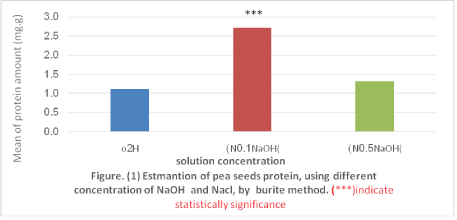
Figure 1: Estimation of pea seeds protein, using different concentration of NaOH and Nacl, by burite method.


Huda Elgubbi1* Adel Alajtal2 Nazer Dabri2 Saad Aboualkasem3
1Department of Environment, Faculty of Environmental and Neutral Resource, Misurata University, Libya*Corresponding author: Huda Elgubbi, Department of Environment, Faculty of Environmental and Neutral Resource, Misurata University, Libya, E-mail: Elgubbi@Sci.miuratau.edu.ly
Proteins were obtained from pea seeds. Protein solubility, water and oil absorption capacity, emulsifying capacity and emulsion stability, foaming capacity and foam stability were used to determine the pea a chemical and functional properties of protein. The pea protein, obtained by alkaline (NaOH 0.1 N) solubilization (pH 10) and 1:10 (gm/ml) ratio followed by TCA/Acetone precipitation, displayed the highest protein content and the best functional properties. The profiles of the solubility curves corresponding to the participated pea protein (PPP) indicate a minimum solubility at pH ranging from 4-10. The emulsifying capacity of pea participated pea protein was low (3.2) but it has high emulsifying stability (98.9). PPP show a high foaming capacity at pH2 and the suitable time to form the foam is 30 min. the high stability of foam was 78.8%. The result of this study emphasized that PPP has an ability to absorb water more than oil. Thus, the experimental suggesting that PPP can be successfully used as food ingredient due to its nutritional value, chemical composition and functional properties.
Pea; Isolated Pea Protein (IPP); Participated Pea Protein (PPP); Chemical and functional properties
Legumes are important crops that play a major role in human and animal nutrition. Furthermore, they are considered as a good source of complex carbohydrates and dietary fiber as well as the proteins and minerals. The common pea (Pisum sativum L), is one of the oldest crops that used for human and animals. These kinds of crops can resistance a cold weather in all stages of grow, and it could be an exceptional alternative to soybean in cold region of the world. Field pea is identified as a main source of nutritional constituents and can be fractionized into many ingredients and foods products enriched in protein, starch, fiber etc [1]. In general, pea seeds contain 20- 25% protein, 40-50% starch and 10-20% fiber [2,3]. Many features that made a pea protein popular in worldwide such as its low cost, availability, and health benefits.
Pea proteins are well characterized with genetic polymorphism [4]. All protein sequences database are available at http://www.expasy.org, which showed that pea seeds continent 638 amino acid sequences of proteins and polypeptides found in different pea varieties, including seed storage proteins [5]. In general, pea protein categorized to four main groups glutelin, prolamin, albumin and globulin, the content of each protein considered as 2-4%, 4-5%, 18-25% and 55-65% respectively, it is clear that globulin and albumin are the highest content protein in pea seeds [6]. The highest components of the globulin fraction are globulin 11S-legumin and globulin 7S-vicilin [7]. The amino acid sequences of pea legumin are similar to those distinguished in soybean legumin.
Legumin is composed of two subunits an α-chain which contains significant acidic amino acids, and a β-chain that contains significant quantities of basic amino acids, with molecular weight about 40 kDa and 20 kDa respectively. The two subunits of legume in linked together by di-sulfide bond and give total molecular weight of 330 kDa. On the other hand, Pea vicilin contains three chains α (19 kDa), β (13.5 kDa) and γ (16 kDa) [5].
Proteomic analysis in pea seed is developing as a highly suitable tool in biochemistry research, including in studies of nutritional constituents. Many biochemistry methods can be used to extract and participate pea protein, and to determine physiochemical properties such as solubility, emulsification, foam ability, viscosity and hydrolysis. Therefore, the object of this study was to determine the physicochemical and functional properties of pea protein and determine their potential uses in food, and also using different technique to participate the protein and to determine the optimum condition for protein purification and protein purification condition.
Sodium hydroxide (BDH), sodium chloride (PARK), acetone (BDH), hydrochloric acid (MERCK), petroleum ether (MERCK), ammonium sulfate, trichloroacetic acid (Fluka), Potassium iodide (BDH), Copper (II) sulfate pentahydrate (Fluka), Potassium sodium tartrate (Fluka), albumin (Fluka), Demineralized water (Fluka), Corn oil, Mercaptoethanol, Acrylamide (BDH), Bisacrylamide (BDH), Butano (MERCK), Acetic acid, Glycerol (BDH), Tetramethylethylenediamine (TEMED-BDH), Tris Hydrochloride (Tris HCl), Sodium dodecyl sulfate (SDS-Fluka), Ammonium persulfate (APS-Pharamacia), and Glycine (Oxoid).
Green Peas was collected randomly from local market at is Urata city. After removing all impurities, the peas grounded using laboratory grinder may times to make it ready for chemical analyses.
The physicochemical properties such as moisture, fat measurement are under the study. The protein content of the seeds was determined using micro-kjeldahl method.
Relative humidity is the water amount that lost from the seeds after dried it in oven, up until weight stability. The humidity estimated [8] after dried the sample in oven at 150°C for two hours. After that, 4.632 g of the powder used to evaluate the relative humidity according to the following equation (1).
\[{\rm{Relative humidity (\% )}} = \frac{{{\rm{sample weight before drying - sample weight after drying}}}}{{{\rm{sample weight before drying}}}} \times 100 - - - - - (1)\]
Nitrogen is the major element next to carbon, hydrogen and oxygen found in living Things. Nitrogen estimated using micro-kjeldahl method. In this method the nitrogen in protein is converted to ammonium sulphate by H2SO4 during digestion. 2 g of the sample and calculated as following (2).
\[{\rm{Total amount of proteins\% }} = \frac{{{\rm{calibration volume}} \times 0.014 \times 6.25}}{{{\rm{sample weight}}}} \times 100 - - - - - (2)\]
The ash refers to the non-organic materials in the peas. The ash determined in 0.289 g of pea’s powder as following equation (3).
\[{\rm{Total amount of Ash\% }} = \frac{{{\rm{Weigh of dry sample before burning - Weight of sample after burning}}}}{{{\rm{Weigh of dry sample before burning}}}} \times 100 - - - - - (3)\]
Crude fat was determined for pea powder gravimetrically by Swedish tube extraction using petroleum ether according to the method of [9].
Biuret test: The biuret reagent was prepared by dilute 3 g of copper (II) sulfate pentahydrate with 9 g of potassium sodium tartrate in 500 ml of sodium hydroxide 0.2 mol than 5 g of potassium iodide was added to the solution, shake well and continue the volume with sodium hydroxide 0.2 mol until one liter. The concentration of purified protein was calculated using spectrophotometer by comparing the intensity of purified Peas protein with that of a series known concentrations of Bovine Serum Albumin (BSA).
Variable conditions were applied to protein extraction form the seeds. The variation was in solvent type, when used three types of solvent, distilled water, sodium hydroxide, and sodium chloride. As well as, used different concentration of solvent to the seeds powder. Other conditions were optimized such as used different temperature (25,30,40,45,50)°C. pH which determined at (1.03,1.97,3.08,5.19,6.24, 7.15,8.05,9.07,10.7,12.07). In the last optimization of time of extraction in (30,60,74,90) min.
Proteins precipitated using TCA/acetone modified method as described by Isaacson T, et al. [10].
Seeds pea powder was suspended in 10% TCA/acetone and kept at -20°C overnight. Then, the samples were centrifuged for 30 min at 5,000 g at 4°C. The resultant pellets were washed with cold acetone twice, each step involved a centrifugation for 10 min at 5,000 g at 4°C. The protein precipitates were air-dried for (1-3 min) and then kept at 4°C for long-term storage.
Protein solubility [11]: Protein solubility was estimated in water (0.02 g/2 ml water), at different PH (10-8-4-2), with stirring for 30 min at room temperature. After that, centrifuged the solution for 30 min, then the protein concentration determine in the supernatant using biuret method.
Foam capacity and foam stability: The 0.1 g of each sample was mixed with 10 ml of distilled water, with different of PH (2- 4- 8- 10) and shacked them for 5 min. the value of formed foam monitored at different times (0- 30- 60- 90- 120) min. the method of foam capacity was calculated (4).
\[{\rm{FC(\% )}} = \frac{{{\rm{foam volume}}}}{{{\rm{initial sample volume}}}} \times 100 - - - - - (4)\]
The foam was left for different interval times (0- 30- 60- 90- 120) min to test its foam stability then foam volume remaining from the FC test was measured, and Foam Stability (FS) was calculated (5) as follows.
\[{\rm{FS(\% )}} = \frac{{{\rm{foam volume after the tested times}}}}{{{\rm{initial foam volume}}}} \times 100 - - - - - (5)\]
Determination of emulsifying properties of pea’s proteins: The emulsification between distilled water 5 ml and commercialized corn oil 5 ml was determined [12] when added 0.07 g of isolate pea proteins. With pH 7 the emulsion measured by centimeters and calculated by Lu ZX, et al. [6]. Furthermore, the stability of the emulsion determined by heating the emulsion in water path at 900°C for 30 min, then cold down to room temperature.
\[{\rm{ES(\% )}} = \frac{{{\rm{VB - VAd}}}}{{{\rm{VB}}}} \times 100 - - - - - (6)\]
VB and VA refer to the aqueous phase prior to heat and after heating at 900°C for 30 min.
Estimation of viscosity: The viscosity of all samples was estimated at different temperature (25, 35, and 45)°C using an ubbelohde viscometer. The samples were prepared by adding 0.1 g of isolated pea protein to 10 ml of distilled water.
Oil binding capacity: The mixture of 0.125 g of isolated protein was mixed with 2.5 ml of commercialized corn oil was shaken for 30 min. Then the mixture left for 30 min at room temperature before centrifuged at 4000 rpm for min. lastly the oil binding capacity was measured according to the method outlined by Sosulski FW, et al. [13]. The oil absorption capacity was expressed as g water absorbed/g protein.
Water binding capacity: A similar method was used to measure that mentioned previously in fat binding capacity except the oil alternated with water.
The protein compositions of isolated pea protein were visualized using SDS-PAGE under reducing conditions (10 mM 2-mercaptoethanol) on a mini-protean II system (Bio-Rad Laboratories, Hercules, CA, USA) according to the instructions of the manufacturer. Gels were stained with Coomassie Brilliant Blue (CBB).
Protein extractions were performed once and the resulting isolates were used for further analyses. All analyses were performed in triplicate, and the results are expressed as mean values ± standard deviations. The results of the sensory analysis were analyzed using one-way ANOVA followed by Tukey’s post hoc test. All statistical analyses were performed using SPSS and were considered statistically significant at p<0.05.
The table 1 below shows the chemical structure of pea’s seeds powder.
| Pea Components | Percentages | |
| 1 | Proteins (in 2 gm) | 5.3 |
| 2 | Ash (in 0.289 gm) | 3.8 |
| 3 | Moisture | 9.5 |
| 4 | Fats | 2.3 |
The protein contents of the pea seeds powder reached up to 5.3%. The ash and fat contents ranged from 3.8% to 2.3%. The fat and ash contents obtained in this study were within the ranges of different cultivars investigated in other studies [14-16].
The reported protein content of seed pea powder was 5.3 %. The protein contents were not in the same range as in other studies [17,18]. The great variability of the protein content and composition has been reported by many authors, both between genotypes and also due to environmental effects within genotypes [19,20]. Klein and Raidl [21], explained that environmental factors which affect protein content of field pea include nitrogen fertiliser, maturation, soil P and K content and temperature.
Effect of solvent concentration on DPS protein extracts: Figure 1 shows the effect of different solvent on proteins extraction. As well as, shows that the highest protein extract (2.7 mg/g and 1.9 of total seed’s weight) were observed in NaOH (0.1 N) and NaCl (1%) and were highly significant different (P=0.001) from NaCl (5%) and H20 which had the lowest extractable protein, the amount of extracted protein, by NaCl (5%) and H20 were 0.1 and 1.1 mg/g of total seed’s weight respectively.

Figure 1: Estimation of pea seeds protein, using different concentration of NaOH and Nacl, by burite method.
A study done by Redant L, et al. [22] reported that The proportion of protein extracted increases from 57.2 % to 61.5% as the alkali concentration increases from 0.01 M up to 0.1 M. this result in consequence with the result observed in this study protein extract using NaOH (0.1 N), and also NaCl (1%=10 N). This suggests that pea proteins are less soluble and It is possible that higher concentrations of NaOH than 0.05 N could cause protein modification [23,24] explained that a higher alkaline concentration is believed to help break hydrogen bonds and to separate hydrogen from acidic amino acid side chains and sulphate groups. However, high concentration could lead to protein modification and cause disaggregation of the proteins as well as reduction of the molecular size making it less soluble. In general, several researchers [24] emphasized that concentration around 0.1 M give optimum extraction conditions for some protein powders.
Extraction methods with water are considered less efficient compared to other extraction methods such as extraction with salt, acids or alkalis, and therefore the results of this study agree with the study of [25,26] from where water is considered to be less efficient in extracting protein.
The results of this study also agree with the study of [27-31] that the use of alkaline solutions is one of the best methods for extracting soluble proteins. The results of [32] study showed that high-base solutions that have a pH of 10 or more increase the amount of extracted protein, and therefore this agrees with the results of the study, which confirmed that using sodium hydroxide solution as a base solution is only 0.1 N (pH=12) was more efficient in extracting proteins from peas compared to water.
Determining the optimum ratio for extraction: Figures 2 and 3 shows the effect of extraction ratios for pea proteins using 0.1 N NaOH (pH=12) and water as an extraction solution in a time of 45 minutes. The extractable protein, using sodium hydroxide solution, increased from 1.51 mg/g of total protein to 0.86 mg/g of total pea protein when the Isolated Pea Protein (IPP) solvent ratio was increased from 1:10 up to a ratio of 1:25. At the mass volume ratios start from (1:15 and above) there are a decrease in the total of extract able protein. A highly significant (p=0.001) decrease in extractable protein observed in figure 2 at the IPP: solvent ratios above 1:15 may be connected with the coextraction of other ingredients from the powder, which form insoluble complex aggregate with the soluble protein as earlier stated [33].
Figure 3 has shown the effect of extraction ratios for pea proteins using water as a solvent. The extractable protein shown an increase from 2.09 to 7.52 mg/g to total protein when the isolated pea protein (IPP): solvent ratio was increased from 1:10 up to a ratio of 1:40. At the mass volume ratios start from (1:15 and above) there are an increase in the total of extractable protein. A highly significant increase in extractable protein observed in figure 2 at the IPP: solvent ratios above 1:40. From the above results it’s clearly the optimum solvent to powder ratio is specific to the type of solvent.
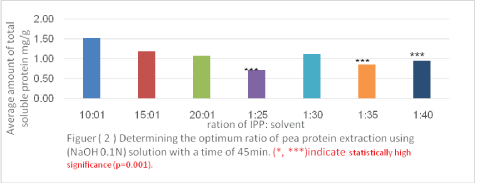
Figure 2: Determining the optimum ration of pea protein extraction using (NaOH 0.1N) solution with a time of 45 min.
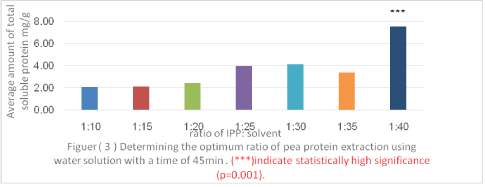
Figure 3: Determining the optimum ratio of pea protein extraction using water solution with a time of 45 min.
Effect of temperature on DPS protein extracts: Figure 4 shows that the amount of extractable protein in alkaline phase (NaOH) highly significance increases (p=0.001) from 0.5 to 3.9 mg/g of total protein as the temperature increases from 4 to 50°C. Thus, protein solubilization increases as the temperature is raised from 0°C to 50°C according to [34] up to a temperature (50°C) where non-covalent bonds become destabilized and secondary and tertiary structures are lost [35]. Also explained that Protein denaturation induces interaction between hydrophobic groups, which leads to precipitation and decreased solubility. Hydrophobic interactions increase greatly between 0°C and 60°C and, long periods using high temperature of 60°C or more could denature the protein [36,37], however, 50°C would be a suitable choice for IPP protein extraction.
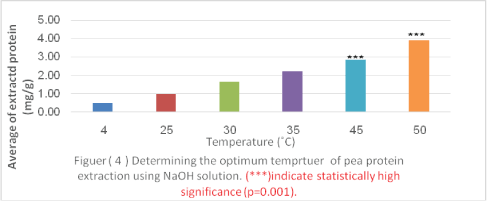
Figure 4: Determining the optimum temperature of pea protein extraction using NaOH solution.
Figure 5 shows the amount of extractable protein in an aqueous phase. the amount of extractable protein highly significant (p=0.001) increases from 2.66% to 3.68 mg/g of total protein as the temperature increases from 4 to 35°C, and then decreased above this. Also high significant reduction in of the amount protein has been noted at the degree 25 and 30°C. Thus, the result indicated that, there is no need to raise the temperature above 35°C, which results in a decrease in the amount of extracted protein.
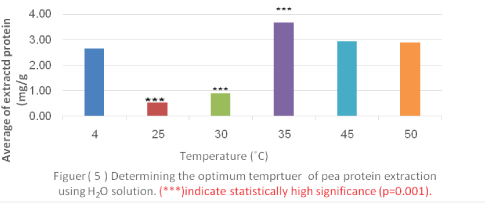
Figure 5: Determining the optimum temperature of pea protein extraction using H2O solution.
Effect of extraction time on IPP protein extracts: The effect of extraction time on extractable protein, by NaOH and 1:40 as a ratio, is shown in figure 6. The amount of extractable protein has shown a slight decrease from 1.72 at an extraction time of thirty minutes to a maximum of 1.40 for an extraction time of ninety minutes. Above an extraction time of 30 minutes the amount extraction of protein becomes constant within statistical limits. However, an extraction time 30 minutes is the optimum time for IPP extraction.
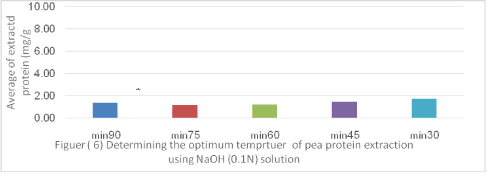
Figure 6: Determining the optimum temperature of pea protein extraction using NaOH (0.1N) solution.
Protein extraction, using an aqueous phase and 1:40 as a ratio, shown in figure 7. It is clear that a long extraction time of more than 60 min had very little influence on the extraction of IPP protein. The slight decrease in average extracted protein for extraction time 60 min could be due to the possible low protein solubility or could be due to the possible aggregation of soluble protein with other food components [38].

Figure 7: Determining the optimum temperature of a pea protein extraction using H2O solution.
Effect of pH on extraction of IPP protein: The effect of different pH values on extractability of isolated pea seed protein is shown in figure 8.
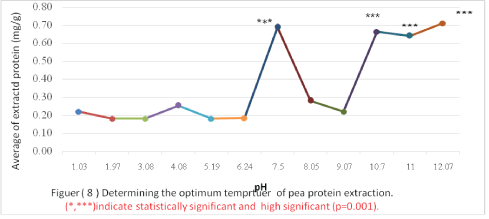
Figure 8: Determining the optimum temperature of pea protein extraction.
High extractable protein was obtained in alkaline and neutral pH were (P=0.001).A0.69 mg/g of the total protein in IPP was extracted at pH 7 (P=0.001) which decreased to 0.28 and 0.22 mg/g at pH 8, pH 9 respectively, but increased again to 0.66, 0.62 and 0.77 mg/g at pH 10, 11 and 12 respectively (P=0.001). Optimum extraction of seed proteins at alkaline pH has been observed before. Results of the study done by Abu-Tarboush HM, et al. [39] emphasized that the highest protein extractability for Hibiscus sabdariffa was at pH 11.0. The relatively high amount of IPP proteins at pH 7 is may due to soluble proteins. One conclusion is that the most of IPP proteins are water soluble.
Seeds Pea Protein Participation (PPP): Protein was participating using the following methods: modified TCA/Acetone [40] and ammonium sulphate, Acetone methods. A total of 2 gm was prepared to participate proteins from seeds pea. According to the result the highest protein content of the prepared powder was obtained using TCA/Acetone (0.98 gm) then 40% ammonium sulphate (0.07 gm) while the lowest protein extract was obtained by actenoe (0.003 gm). The increase in the amount of participated by modified TCA/Acetone methods can be explained by the removal of contaminating sugar or fat molecules during participation. However, because the TCA/ Acetone modified method gave the highest quality of protein in the final powder (49% w/w) this powder was used for to study the finical proprieties of proteins.
Solubility: The solubility profiles of field pea protein participates (PPP) are shown in figure 9. This includes those extracted at pH 2, pH 4, pH 8, and pH 10. Pea proteins are soluble and the solubility of PPP increased with an increase in the pH degree. the minimum solubility was recorded at pH values in the range of pH 2 to pH 4, and the higher solubility, was recorded, at pH 8, and pH 10 were (p=0.03). This result agreed with the results demonstrated by Damodaran S, et al. and Tian SJ, et al. [41,42].
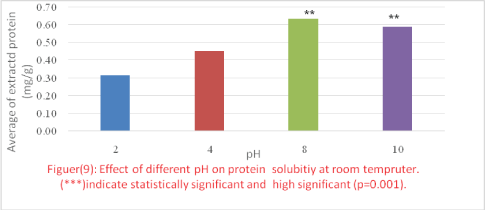
Figure 9: Effect of different pH on protein solubility at room temperate.
Foaming capacity and foam stability: The effect of PH and time on foam capacity and stability of PPP is shown in figures 10 and 11 respectively.
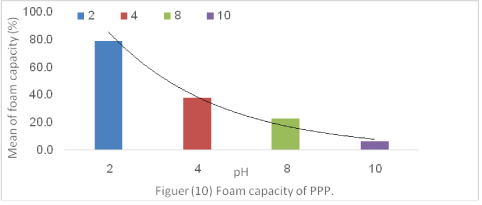
Figure 10: Foam capacity of PPP.
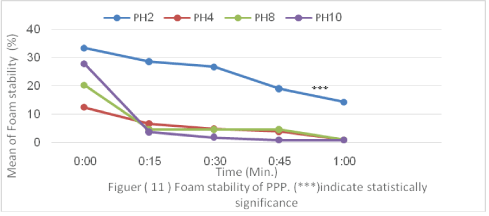
Figure 11: Foam stability of PPP.
The PPP had both the highest foaming capacity, at a pH2, as well as the highest foaming stability of PPP was recorded at pH2 (Figure 9).
Foaming stability and capacity are influenced by time and pH. according to the results shown in figure 9 foaming capacity highly formed at pH2 (78.8%) the lowest reduction in the foaming capacity was recorded at pH10 (6.5%) were (P=0.001).this is consistent with what was mentioned by Sathe S, et al. [43] that the foam formed from the protein isolated from lupine seeds increases at high acidic media, and he explained [44] that the ability to form foam is affected by the pH value. Also, the stability of the foam is affected by the time factor, where the highest percentage of stability of the foam was recorded in a time of 30 minutes at pH=2, and the percentage of foam capacity was 78.8%, while at pH (4,8,10) it was noticed that the decrease in the percentage of foam capacity reached (38,22.8, and 6.5%), respectively, and therefore it can be seen that alkalinity affects the results of foam formation as it reduces the amount of foam formed as well as its stability. And the increase in the foam capacity is due to the increase in the electrical charge of the protein and then the increase in the solubility and flexibility of the protein, which results in the diffusion of the protein at the interface (water-air) and surrounding air bubbles, and then increasing the formation of foam.
The lowest foam stabilities at pH 4,8,10 may be due to the presence of polysaccharides or due to aggregation or denaturation.
Determination of emulsifying property: The result illustrated in figure 12 clarified that PPP has low emulsification activity (3.2%) but it has higher emulsification stability (98.9%). The decrease in the emulsifying activity of the protein may be due to the protein reaching the electrolyte point, which causes it to precipitate and reduce its emulsifying activity. The emulsifying property of protein is important to forms a gel structure with water by imbibing it and binding to it, Protein prevents slow melting. Thus reducing the free water in the mixture.
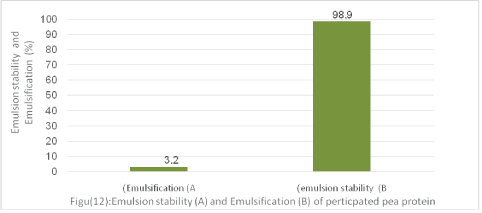
Figure 12: Emulsion stability (A) and Emulsification (B) of perticated pea protein.
As for the stability of the emulsification, it was clear from the results that PPP has a high percentage of stability, and the percentage of stability of the emulsifier was high in the medium at pH=7. It was explained by Keerati-u-rai M, et al. [45] that the stability of the emulsion depends on the formation of a charged layer through the dissolved proteins around the oil droplets, leading to the repulsion of the droplets with each other. Which has an effective surface with the ability to emulsify and its stability through the stable electrostatic force on the surface of the fat drop [46].
Oil and water absorption capacity: Oil capacity of PPP was lower (3.2 ml/g) compared with its capacity to absorb water (4 ml/g). The relatively low absorption capacity of oil (Figure 13) may be attributed to the denaturation degree of protein [47].
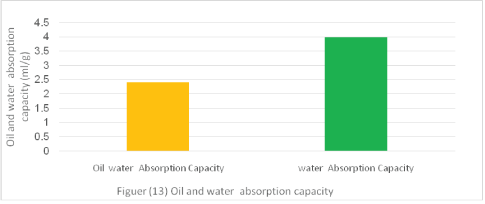
Figure 13: Oil and water absorption capacity.
PPP protein could be used as a thickener in soups and gravies as mentioned by [48].
The functional properties of pea seeds obtained in this study suggest its potential for the development of different food products. The findings of this study show that isolated pea proteins (IPP) are rich in proteins. In order to, extract protein from pea seeds, the results of this study show that pea protein isolates are rich in proteins. In order to extract protein from pea seeds, optimal extraction conditions must be recognized. The results of the study confirmed that the extraction of pea proteins requires the following optimal conditions: a ratio of 1:10 (g/ml) in alkaline media or 1:40 in aqueous media, 30 min. in both NaOH (0.5 N) or in aqueous media, (p H 10-12), 50°C in NaOH or 30°C. The optimum participation method used in this study is TCA/ Acetone methods. The results obtained for pea protein participated (PPP) including protein solubility, water and oil handing capacity, foaming stability and capacity, emulsion stability and capacity. The PPP exhibit a good foaming and emulsion stability, as well as water capacity which could be exploited for nutrition and food formulation.
The author would like to thank the Biomedical and Research Office at Misurata university for helping.
Download Provisional PDF Here
Article Type: RESEARCH ARTICLE
Citation: Elgubbi H, Alajtal A, Dabri N, Aboualkasem S (2022) Evaluation of Physicochemical and Functional Properties of Isolated Pea Protein. Nutr Food Technol Open Access 8(1): dx.doi.org/10.16966/2470-6086.177
Copyright: © 2022 Elgubbi H, et al. This is an open-access article distributed under the terms of the Creative Commons Attribution License, which permits unrestricted use, distribution, and reproduction in any medium, provided the original author and source are credited.
Publication history:
All Sci Forschen Journals are Open Access